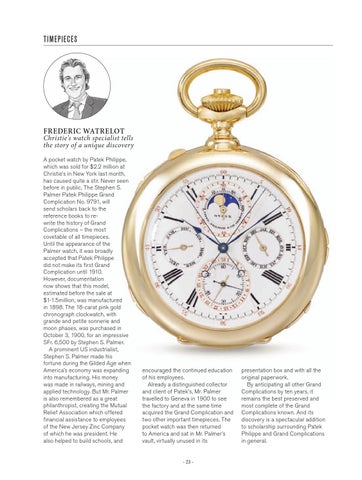Timepieces
Frederic Watrelot Christie’s watch specialist tells the story of a unique discovery A pocket watch by Patek Philippe, which was sold for $2.2 million at Christie’s in New York last month, has caused quite a stir. Never seen before in public, The Stephen S. Palmer Patek Philippe Grand Complication No. 9791, will send scholars back to the reference books to rewrite the history of Grand Complications – the most covetable of all timepieces. Until the appearance of the Palmer watch, it was broadly accepted that Patek Philippe did not make its first Grand Complication until 1910. However, documentation now shows that this model, estimated before the sale at $1-1.5million, was manufactured in 1898. The 18-carat pink gold chronograph clockwatch, with grande and petite sonnerie and moon phases, was purchased in October 3, 1900, for an impressive SFr. 6,500 by Stephen S. Palmer. A prominent US industrialist, Stephen S. Palmer made his fortune during the Gilded Age when America’s economy was expanding into manufacturing. His money was made in railways, mining and applied technology. But Mr. Palmer is also remembered as a great philanthropist, creating the Mutual Relief Association which offered financial assistance to employees of the New Jersey Zinc Company of which he was president. He also helped to build schools, and
encouraged the continued education of his employees. Already a distinguished collector and client of Patek’s, Mr. Palmer travelled to Geneva in 1900 to see the factory and at the same time acquired the Grand Complication and two other important timepieces. The pocket watch was then returned to America and sat in Mr. Palmer’s vault, virtually unused in its
- 23 -
presentation box and with all the original paperwork. By anticipating all other Grand Complications by ten years, it remains the best preserved and most complete of the Grand Complications known. And its discovery is a spectacular addition to scholarship surrounding Patek Philippe and Grand Complications in general.
